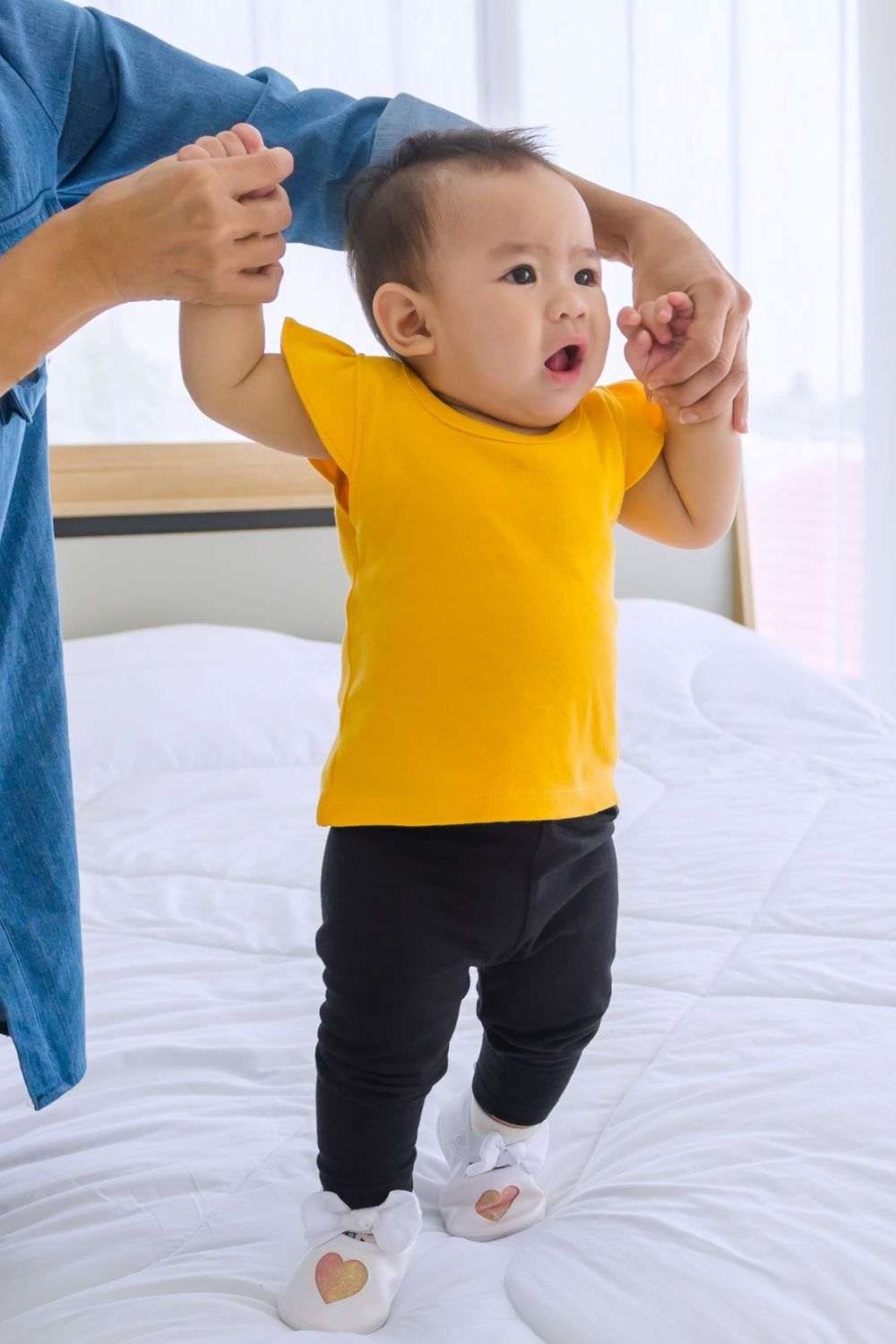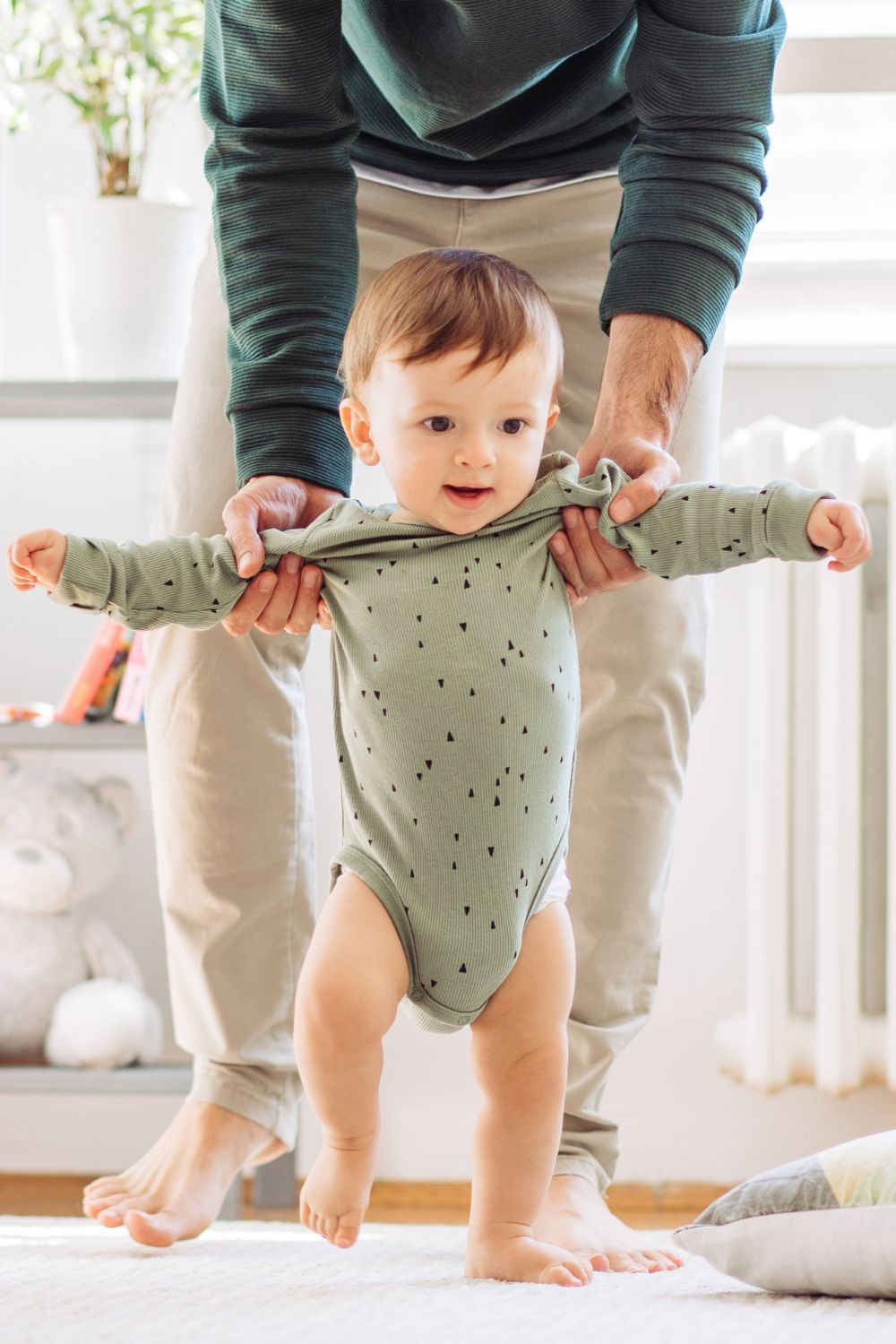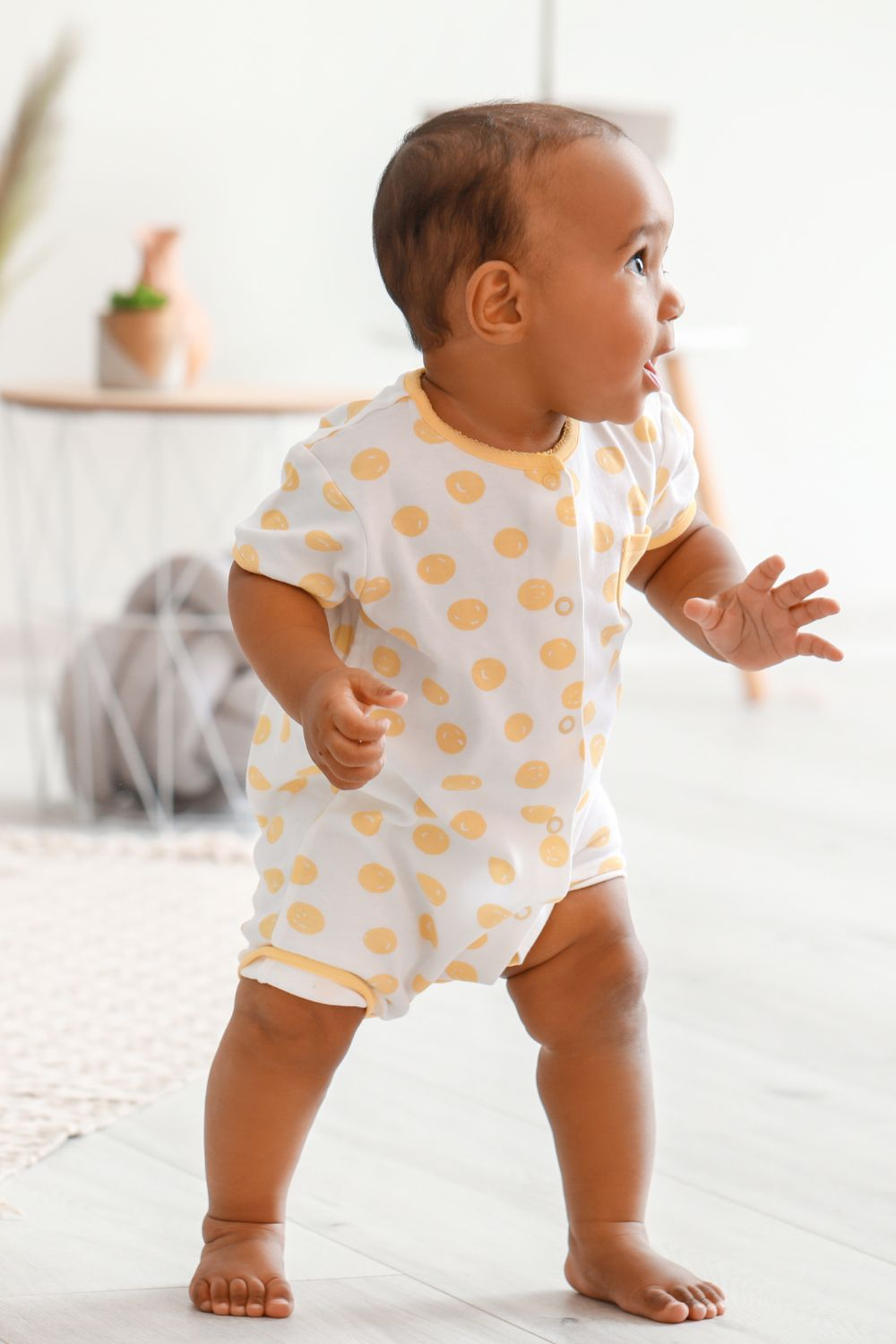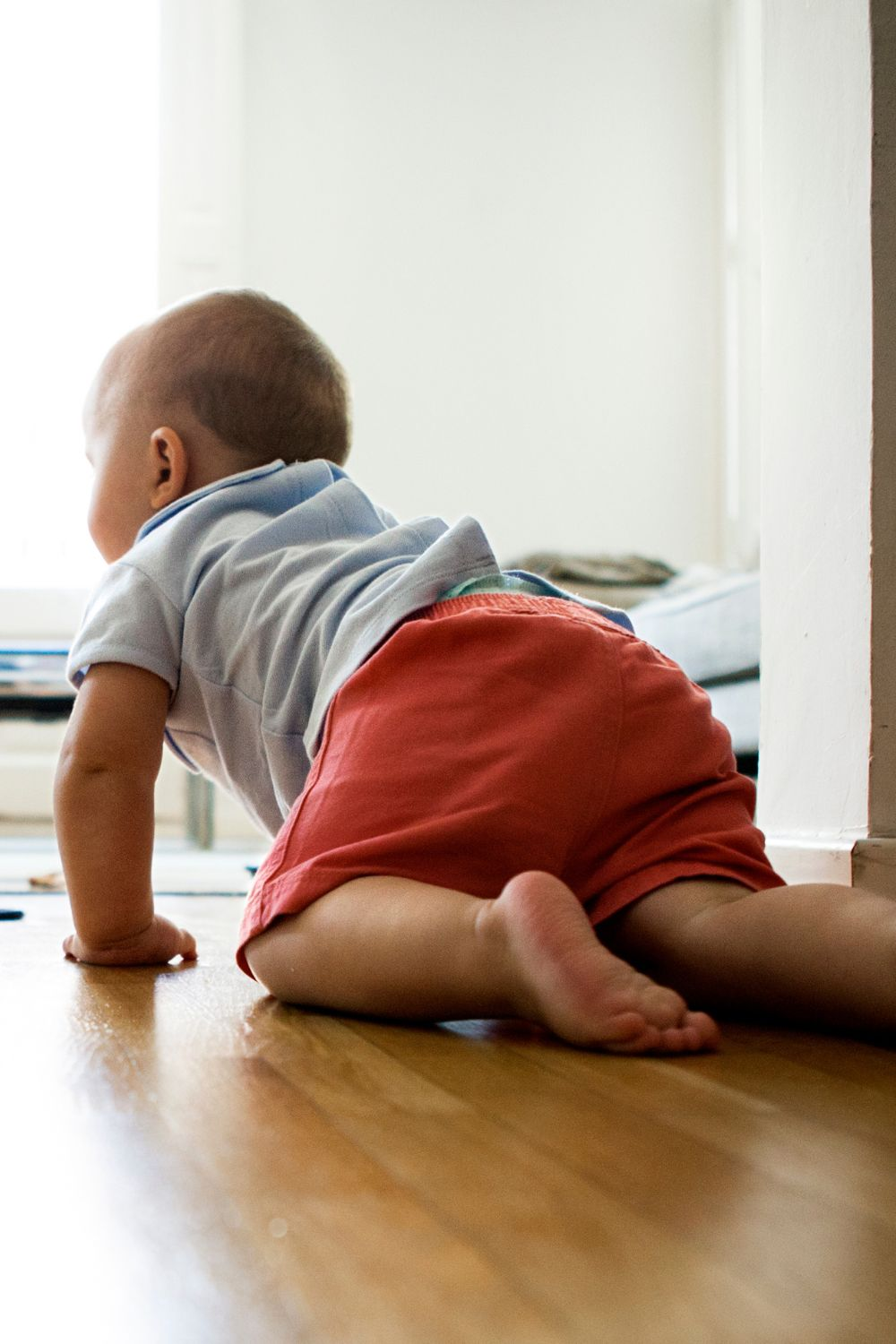The first year of the baby is full of developmental milestones. Eating solid food, crawling, sitting, standing and walking are important milestones achieved during the first year.
Usually, babies start walking around 10 to 12 months. But for some babies, there will be a delay in achieving this major milestone. They may start walking only after 14 months. This naturally rings the alarm bell. But do not worry, as different babies achieve developmental milestones at different stages of growth.
What Are The Different Stages Of Walking?

Babies usually go through different stages before they start walking. This includes
Crawling
Babies use their hands and knees to crawl on the ground. Crawling usually happens around 7 to 10 months. Some babies might stand on their knees and hands and rock back and forth.
Creeping
While creeping, babies make an attempt to move forward with the support of their hands, with the rest of the body dragging behind. They may not use their legs to move forward.
Cruising
This is the stage just before walking. At this stage, the baby holds on to some object, like a piece of furniture, and takes small steps.
How Do Babies Learn To Walk?
When a baby is born, all body muscles are weak. By the time the baby is 6-7 months of age, they start crawling. They start bouncing up and down when you hold them in a standing position. This gradually strengthens the baby’s leg muscles, which is the first step towards helping them to walk.
Once the baby is 9-10 months, they hold objects like furniture and attempt to stand. Some babies may even lift their legs up and down. Gradually the baby gains the confidence to leave the object and walk independently.
Walking is a mix of balance and confidence. Since each baby achieves this at different stages, their walking pattern also varies.
What Are The Signs That The Baby Is Ready To Walk?

There are certain developmental milestones that indicate that the baby is ready to walk. This includes
Pulling Up And Standing
By the time the baby is 8-9 months, they pull up on some hard surfaces like furniture and stand. This is the first sign that the baby is ready to walk.
Pulling up and standing provides proper strength to the baby’s leg muscles which eventually helps them to walk.
You can encourage the baby to pull themselves up by saying words like “up” and “down” for squatting.
Showing Up Their Adventurous Side
If you notice the baby suddenly climbing up the sofa and standing, it shows they have the confidence to do new things.
This confidence plays a crucial role in letting the baby walk. However, as parents, you should be extra cautious as the chances of an accident are high.
Cruising
Cruising means walking around holding onto something like a piece of furniture.
Cruising around shows the baby’s ability to shift weight and balance, which is crucial while walking.
To encourage cruising around, you can create a safe path with furniture through which the baby can safely walk.
Irritability And Change In Sleep Pattern
Every developmental milestone calls for crying, whining, and a change in sleep patterns.
The same applies to walking as well. If you notice the baby showing any of the above, it indicates that the baby is ready to walk.
But do not worry, as things will fall in place once the baby starts walking.
Standing Without Support
Standing without support requires a lot of confidence and balance. If your baby can stand without support, it indicates that the baby has enough confidence to walk.
How Can You Help Your Baby Learn To Walk?

If the baby does not attempt to walk by 14 months, parents can guide them in this activity.
You can sit on the floor, hold the baby’s hands, and slowly guide them to walk. This enables the baby to lift the legs and slowly move forward.
It is very important to give enough floor time to the baby. This helps the baby to crawl, hold and stand and eventually walk.
Though carrying the baby around is more convenient, floor time is equally important for the baby’s normal growth.
You can also use a baby walker or a push toy to help the baby walk. But you should always supervise the baby while using these gadgets.
Also, you should limit the time the baby spends on these gadgets as they have their own limitations.
How To Encourage Your Baby To Walk?
It is very important that you encourage the baby to walk. This way, the baby feels like taking the risk and moving ahead. Below are a few ways you can encourage the baby to walk.
Extend A Hand And Encourage
When the baby is ready to walk, you should extend both hands and encourage them to come close to you.
Provide constant support and encouragement as the baby starts taking their first steps. This will help them feel more secure and confident, which is important when encouraging independent walking.
As the baby reaches out for your hand, make sure to hold it securely but not tightly and just provide support as most toddlers will be nervous when starting these expected milestones.
Once the baby gains confidence, you can slowly move to another room with outstretched hands. This way, the baby will move forward from one room to another.
Praise Your Baby
Praising your baby once they do start walking is immensely important! It will help grow the babies confidence and self-esteem, making learning to walk more fun and enjoyable for the baby.
Once the baby starts walking, you should praise them by saying ‘very good’ or by giving them that special kiss. This will encourage the baby to take more steps.
Physical gestures can be a great way to motivate your baby as they develop their motor skills. Clapping and showing enthusiasm is a huge and great way of helping your baby become more confident.
Comfort Your Baby
Falling is a normal part of walking. It’s to be expected as babies take their first steps. However, it can be incredibly frustrating for a new baby, and even scary sometimes.
When the baby falls, you should comfort them with kind and soothing words. Give them plenty of reassurance and encourage them to ty again.
Phrases such as ‘you’re doing great’ and ‘you’ll get it next time’ are a great way to reinforce and encourage child development.
You may also want to provide physical comfort by picking them up, offering kisses, hugs, and holding their hands. Especially if the baby started crying, these comforts will keep them cal and make them feel safe and loved.
Babyproofing the house is a good idea to prevent major falls and injuries. This will create a safe environment for them to explore and learn to walk.
Create Challenges
Once the baby is comfortable walking on a flat surface, you should challenge them to walk on uneven surfaces like a mattress.
Walking on a mattress can help challenge their balance and coordination, and even help with muscle strength and balance out any muscle weakness that could exist.
This will help their overall walking ability and help babies begin walking on their own more confidently.
Once the baby is comfortable on a soft surface, like the mattress, you can introduce other uneven areas, like grass or carpet.
This will provide a continuous challenge and further develop their strength and coordination.
Create Tempting Trails
Tempting things like a colorful toy can encourage the baby to move forward. When the baby is ready to walk, you can place exciting things in front to encourage them to walk.
Babies are naturally drawn to colorful and interesting objects, and creating an enticing trail is a great way of encouraging those first steps.
You can also place a toy far away from your baby, encouraging them to walk to it. You can gradually increase the distance they have to walk as they start taking more steps slowly
Create A Cruising Path
Some babies might be afraid to walk because of the fear of falling.
If your baby falls under this category, you can create a cruising path with furniture. This way, the baby can hold on to the furniture if it loses balance.
A cruising path is a designated area n your home where your baby can take their first steps while holding onto furniture for support.
This can be a couch, tables, or chairs. Just make sure they are babyproofed and don’t have any sharp edges to provide a safe and secure path along the home.
The furniture should also be stable and not too high up. The baby should be able to reach it easily and move along the path freely, walking independently.
Give A Push Toy
Small toys like a mini shopping cart or lawn mover make great push toys. This provides enough support to the baby yet encourages them to walk independently.
While giving push toys, make sure that they are sturdy and have strong wheels, so they do not tip over.
What Are The Reasons For Late Walking In Babies?

If your baby does not walk even by 18 months, they can be considered a later wal
ker. There are several reasons for late walking in babies.
Hereditary
Like other developmental milestones, walking is also influenced by hereditary factors. If you or your partner start walking late, there is a great chance for the baby to follow suit.
There is no underlying medical cause for this late walking and no reason for concern.
However, there are some genetic or familial influence that can come into play when it comes to walking.
Hereditary neuromuscular disease is one genetic cause for delayed walking in babies. They affect the muscles and nerves, which are responsible for controlling movement.
These are caused by genetic mutations that affect normal functioning of the muscles and nerves.
Personality
The baby’s personality also plays a key role in deciding when they start walking. If the baby is adventurous and does not mind falling and getting hurt, you will notice them walking early.
Some babies are more cautious and may not take risks. Such babies are more likely to start walking late.
Environment
The general environment in which the baby grows is another factor influencing their walking ability.
If the baby did not get the opportunity to crawl on the floor or hold things and stand, there would be a delay in walking.
Similarly, babies who are ill or go through long-term hospitalization are also likely to experience a delay in walking.
Premature Birth
Babies born prematurely are most likely to experience a delay in walking. This is because all their developmental milestones are delayed.
Premature babies have muscles and bones that aren’t fully developed, causing difficulty in balance and coordination.
They will start walking at the same time they are likely to walk if they were born normally. However, some premature babies may start walking at the same time as full-term babies, while others may experience delays of several months or even a year.
It’s important for parents of premature babies to have realistic expectations of their child milestones and support their timeline.
Diseases
Rare diseases like barth syndrome and Russel Silver syndrome can cause a delay in walking. If this is the case, the doctor will prescribe a genetic analysis to determine the exact cause.
In addition to the above, other health conditions like cerebral palsy and hypotonia can also delay walking.
When Should You Be Worried About Late Walking?

For most parents, it is a matter of concern if the baby does not start walking by 14 months. But before you head to a doctor, you should check whether the baby is meeting other developmental milestones.
Can the baby stand by holding on to objects? Is the baby able to bounce up and down? If the answer to these questions is yes, you need not worry. These are indications that the baby’s motor skill is developing at a normal pace.
However, you should continue monitoring the baby’s progress. If the baby does not walk even after reaching 18 months, you should consult a doctor.
If the baby was born prematurely, all developmental milestones would be delayed. In such a case, you should track the developmental milestones based on the baby’s adjusted age.
When Should You Consult A Doctor?
As mentioned earlier, if the baby does not start walking even by 18 months, you should consult a doctor. Similarly, you should consult a doctor if you notice any of the below conditions.
Flat Foot
A flat foot is a condition in which the feet lack the natural arch. Most baby feet appear to be flat because of the baby fat.
However, even after the baby reaches 2 or 3 years, if you notice a flat foot, you should consult a doctor.
Curvy Foot
For babies with a curvy feet, the feet curve inwards like a half moon. Thus, they are unable to walk.
The curvy foot is caused mainly by neurological conditions or other medical conditions like cerebral palsy.
Pigeon-Toed Foot
The pigeon-toed foot is a condition in which the toes are curved inwards while walking. While most babies will have this condition, it will resolve on its own once they start walking. It is normally no cause for concern.
But even after six months of walking, if the baby has inward toes, you should consult a pediatrician.
Tiptoe Talking
Some babies have the tendency to walk on tiptoes. This is knowns as tiptoe walking, or idiopathic toe walking.
There can be a lot of reasons a child tiptoe walks, from muscle tightness, balance issues, to even using a jumper too often.
If this condition does not get resolved by age 2, you should consult a doctor. Without intervention, it can lead to muscle imbalances, balance issues, and coordination problems.
Luckily, this is typically easy to fix with shoe inserts or orthotics.
What Are The Dos And Donts Of Baby Walking?
Do’s
- Initially, you should hold the baby’s hand while walking. This provides confidence to the baby to walk.
- Once the baby starts walking, provide a shoe with good support. This helps them to walk with confidence.
- Always encourage the baby with a smiling face while walking.
- Stand close to the baby when they walk. This gives them a comfortable feel.
- Once the baby has started walking, put them down in a standing position instead of a sitting position. This provides more strength to their muscles.
Dont’s
- Do not make the baby wear shoes while walking. Walking barefoot provides them with a proper grip for walking.
- Do not make the baby sit on the walker for too long. This is because the baby uses their toes while on the walker and may not walk normally when taken out.
What Are The Other Milestones After Walking?
Once the baby starts walking on their own you will notice the below milestones.
- 16 months – The baby starts climbing stairs with help.
- 18 months – The baby starts grooving to the tune of music.
- 26 months – The toddler starts jumping up and down.
- 36 months – The toddler starts running around.
Conclusion…
Walking is a major developmental milestone for the baby and delayed walking can be very concerning for new parents.
Walking requires a lot of physical strength and confidence. Though the baby will move over this milestone on their own, you should provide them good support and confidence.
Most babies start walking by around 14 months. While some might start walking a bit early, others can be a bit late. However, if your baby does not start walking even by 18 months, you should consult a doctor.
The doctor, after a thorough examination, will let you know any further steps that you need to take.